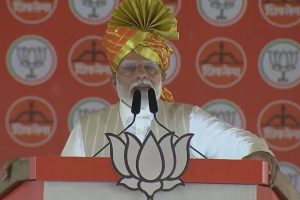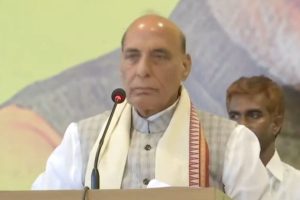The global call for climate action reflects equally in India’s reaffirmed commitment established through its updated Nationally Determined Contributions (NDC) from the 27th Conference of Parties (COP). The country has made some steadfast steps in achieving 50 per cent cumulative electric power installed capacity from non-fossil fuel-based energy resources by 2030 and reducing emissions intensity of its GDP by 45 percent.
The government’s budgetary allocation in actual terms reflects its pri- ority to meet the 2030 target as FY2017-18 to FY2021-22 saw a steady allocation to the Ministry of New and Renewable Energy (MNRE). The net allocation of Gross Budgetary Support and Internal External Budgetary Resources in actuals of FY21-22 was Rs 22463.54 Crores, and the compounded annual growth rate over the last four years has been 11.21 per cent.
As we move towards COP 28 to be held in Dubai where the United Nations will conclude its first Global Stocktake to understand the world’s collective progress towards climate change, the report published in September 2023 clearly indicates that the world is still far off from holding glob- al temperatures at 1.5 degree Celsius.
Despite the serious commitment and numerous policy measures which have been in alignment with the 2030 targets, India still has several chal- lenges to overcome. Across energy, automobile, and manufacturing one such significant issue is of policy inconsistencies which have proved to be a hurdle and have impacted the efficacy of India’s de-carbonization pathway. We will take three examples, across the mentioned sectors, to understand this phenomenon.
India’s major agenda as per the NDC is correctly aimed at decarbonizing energy, as historically the country has been very reliant on fossil fuel-based energy sources. A significant hindrance to the flagship schemes of the government to achieve independence from fossil fuel has been policy inconsistency. A major reason why India could not meet the target of 175 GW renewable energy capacity was attributed to the low solar rooftop and wind energy projects, as stated by a parliamentary panel.
The rooftop solar scheme’s achievement was 7.4 GW out of the 40GW target. The scheme faced some major policy inconsistencies such as the discrepancy in the basic customs duty, net-metering limits to name a few. Let us understand the issue of net-metering to understand how this inconsistency has caused a regression in achieving its desired outcome. Ini- tially a lot of state governments had rooftop solar capacity up to 1MW for net-metering but the 2021 Electricity (Rights of Consumer), 2020 Rules established a guideline lowering it to further to 500KW.
For consumers, the reduction in the price of electricity is the most alluring feature of rooftop solar. The potential savings are dramatically reduced when the net metering limit is halved, especially for big and medium industrial consumers, hence over- all hampering its acceptance.
The manufacturing sector for renewables such as solar also has faced similar issues, and has hampered the overall progression towards India’s targets. In 2010 the Jawahar Lal Nehru Solar Mission (JNNSM) instituted the domestic content category (DCR) which mandated solar projects in the country to utilize domestically manufactured solar cells and modules. This policy was aimed to have a domestic manufacturing base to be able to meet the long term renewable capacity, price parity and market demands. But after FY2010-11, the regulations of mandating DCR kept becoming lower as compared to the open category market.
From the beginning of 2011 to the end of 2012 solar module prices fell by 65 per cent and Chinese manufacturers captured most of the markets.Indian manufactured modules were costlier, hence were not preferred by the developers. This impact could have been minimized and India’s solar manufacturing base could have been in a much better position today but due to inconsistent policies and lack of focus, it will take much longer to achieve this.
A similar inconsistency was very recently observed in the automobile sector. India has also affirmed an intention to decarbonize its automobile sector by setting a target Electric Vehicle (EV ) sales penetration of 30 per cent for passenger automobiles, 70 per cent for commercial vehicles, and 80 per cent for two and three-wheelers by 2030. In order to achieve this, the government approved the Faster Adoption and Manufacturing of Electric and Hybrid Vehicles (FAME scheme) in two phases.
The scheme’s largest impact was seen through the market penetration of EVs in the two wheeler segment, which has the highest market share. Over the years, the market for cleaner vehicles has got steady hand-holding
through policy intervention and sub-sidies, but the recent reform in the FAME II subsidies presents a case of policy inconsistency. FAME II subsidies on electric two wheelers saw incentives cut down to 15 per cent of ex-factory price from the earlier 40 per cent and the demand incentive was cut to Rs 10,000/kWh from Rs 15,000/kWh in June 2023. The impact of this reduction saw a direct impact on the sales of the two wheelers in the Indian market. As per government’s VAHAN website, the two wheeler EV segment saw a drop of registration from 1,06,006 to 46,011 in June 2023.
It is imperative for our policy makers and government institutions to establish more consistent and uniform policies signaling mechanisms to expedite the country’s de-carbonization and just transition. On the brighter side the government’s recent interest in establishing carbon markets through its Energy Amendment Act (2022) shows its commitment to a more consistent and uniform policy.
In last 10 years the share of glob- al emissions covered by carbon taxes and emission trading schemes has grown from 7 to 23 per cent. India has rich experience in various implicit carbon pricing mechanisms such as Coalcess and the recent pilot projects in Gujarat for running ETS programmes in Surat and Ahmedabad municipalities. It is also important to note that the existing regulatory mechanisms are made more fluent and participatory so that inconsistencies between union, state and all other relevant stakeholders can be minimized. In conclusion, India has an urgent need to expedite its effort to remove inconsistencies in existing policies.
(The writer is a Research Consultant at the Climate Finance Vertical at Center for Budget and Governance Accountability (CBGA), a public policy think tank based in New Delhi, India. The views expressed are personal.)











